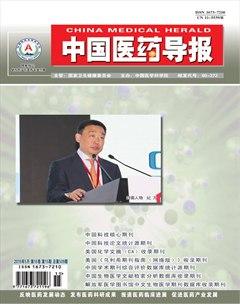大鼠视网膜Müller细胞在高糖、氧化应激、缺氧中的表现
李春花 冯朝晖 张雪 田冰玉 雷晓琴 周婷洁 马为梅

[摘要] 目的 观察Sprague-Dawley(SD)大鼠视网膜Müller细胞在高糖、氧化应激、缺氧三种病理环境下的特征,为糖尿病视网膜病变的防治提供新的研究依据。 方法 体外培养SD大鼠视网膜Müller细胞,并用谷氨酰胺合成酶(GS)鉴定。将传2代的细胞随机分为四组:对照组、高糖组、氧化应激组、缺氧组。倒置显微镜观察细胞形态学改变,免疫荧光染色法观察细胞GS和α-平滑肌肌动蛋白(α-SMA)的变化,Transwell小室观察细胞迁移能力。 结果 体外成功培养并鉴定鼠Müller细胞,四组Müller细胞功能均受损,氧化应激组以及缺氧组结构受损明显,失去正常形态。缺氧组中α-SMA的表达呈阳性,并且在Transwell小室中发生迁移的细胞数明显多于其他组,差异有统计学意义(P < 0.05)。 结论 高糖、氧化应激、缺氧均可导致Müller细胞功能受损,缺氧可诱导Müller细胞转化为具有迁移能力的肌纤维样细胞,提示Müller细胞参与了增生性糖尿病视网膜病变的发病过程。
[关键词] SD大鼠;视网膜Müller细胞;糖尿病视网膜病变;上皮细胞间质转化;Transwell小室
[中图分类号] R587.2 [文献标识码] A [文章編号] 1673-7210(2019)05(c)-0018-04
[Abstract] Objective To observe the characteristics of Sprague-Dawley (SD) rats retinal Müller cells under three pathological conditions including high glucose, oxidative stress and hypoxia, and to provide new research basis for the prevention and treatment of diabetic retinopathy. Methods SD rat retinal Müller cells were cultured in vitro and identified by glutathione synthetase (GS). The second generation of cells were divided into control group, high glucose group, oxidative stress group and hypoxia group randomly. The morphological changes of the cells were observed under inverted microscope, the changes of GS and α-smooth muscle actin (α-SMA) were observed by immunofluorescence staining, and the cell migration ability was observed by Transwell chamber. Results The Müller cells were successfully cultured and identified in vitro. In all groups, the function of Müller cells was impaired, and in oxidative stress group and hypoxia group, the structure was damaged, and the normal morphology was lost. In hypoxia group, the expression of α-SMA was positive, and the number of cells in the Transwell chamber was significantly higher than that in other groups, the differences were statistically significant (P < 0.05). Conclusion High glucose, oxidative stress and hypoxia can destroy the function of Müller cells. Hypoxia can induce transforming into myofibroblast cells with migratory ability, which indicates that Müller cells are involved in the pathogenesis of proliferative diabetic retinopathy.
[Key words] SD rat; Retinal Müller cells; Diabetic retinopathy; Epithelial cell interstitial transformation; Transwell chamber
糖尿病视网膜病变(diabetic retinopathy,DR)是糖尿病的主要致盲原因[1-3],其发病机制复杂,近年来研究表明DR的发生发展与视网膜Müller细胞有密切关系[4-8],其通过调节钠钾平衡、摄取神经递质等来维持视网膜细胞外环境的稳定性[9]。糖尿病时的高糖、氧化应激、缺氧可以使Müller细胞功能受损、结构破坏,关于上述3种病理环境中Müller细胞的损伤是否一致的报道甚少,因此本研究在体外模拟了DR的这3个阶段,来研究Müller细胞参与DR的发病机制,为延缓或逆转其结构及功能异常提供探索性研究。
1 材料与方法
1.1 实验动物
正常出生后7 d的SD大鼠20只,清洁级别,由西安交通大学医学院动物中心提供,许可证号:SCXK(陕)2018-001,伦理号:2018-191,饲养于无特定病原体级(SPF)动物房。
1.2 仪器与试剂
倒置显微镜SZ51型(日本olympus公司);CO2培养箱PYC-16型(美国Scheldon公司);低温高速离心机5810r型(德国Eppendorf公司,半径15.4 cm);恒温水浴箱HH-1型(上海森信研究仪器有限公司)。DMEM培养基(Gibco公司,货号:C1199550BT);胎牛血清(杭州四季青生物工程公司,货号:11011-8611);兔抗鼠谷氨酰胺合成酶(GS)抗体(博奥森公司,货号:BS-1003R);兔抗鼠α-平滑肌肌动蛋白(α-SMA)抗体(博奥森公司,货号:BS-11665R);荧光素偶联的山羊抗兔IgG(Abbkine公司,货号:A22120)。
1.3 实验方法
1.3.1 大鼠视网膜Müller细胞分离、体外培养、鉴定及分组 将出生7 d的SD大乳鼠断颈处死后浸泡于75%的酒精中,挖出眼球,显微镜下分离出视网膜组织,分别加入木瓜蛋白酶(27 U/mL)和0.25%的胰蛋白酶37℃进行消化30 min,后加入含20% FBS的DMEM/F12培养基终止消化。放入37℃、体积分数为5% CO2培养箱培养,2~3 d换液1次。在原代培养5 d时,按1∶3传代,并使用GS鉴别。将传2代细胞液随机分为以下四组:①对照组,细胞未经任何处理。②高糖组,经50 mmol/L的葡萄糖(Glc)溶液处理。③氧化应激组,经100 μmol/L的过氧化氢(H2O2)溶液处理。④缺氧组,经500 μmol/L的氯化钴(CoCl2)溶液处理。
1.3.2 免疫荧光染色 随机取爬片,20%山羊血清室温孵育30 min,封闭内源性IgG,加GS、α-SMA抗体工作液,加1∶200稀释的荧光素标记的二抗,37℃温室避光孵育1 h,20%甘油封片剂封片,荧光显微镜观察,照相。
1.3.3 细胞移行分析 将Müller细胞传代到8 μm孔径滤膜的Transwell小室中,待细胞贴壁达70%后,将细胞随机分为对照组、高糖组、氧化应激组、缺氧组。用预冷的丙酮固定20 min,用细胞刷刮除正面细胞,对透过滤膜小孔移行至滤膜反面的細胞进行苏木紫着染10 min,自来水冲洗5 min。显微镜观察,照相,随机取5个区域计数。
1.4 统计学方法
采用SPSS 18.0统计软件对数据进行分析,计量资料以均数±标准差(x±s)表示,多组间比较采用方差分析,组间两两比较采用LSD-t和SNK-q检验。以P < 0.05为差异有统计学意义。
2 结果
2.1 Müller细胞的体外培养及鉴定
体外培养的Müller细胞呈扁平的多边形融合状生长,形态不规则并有较长的突起。GS是主要鉴别酶,在胞核及胞质中表达。见图1(封三)。
2.2 各组细胞形态学以及功能观察
对照组的Müller细胞描述同前,α-SMA表达阴性;高糖组Müller细胞形态基本同对照组,GS、α-SMA表达阴性;氧化应激组Müller细胞数量减少,细胞崩解,GS、α-SMA表达阴性;缺氧组Müller细胞胞体变大,不规则样突起增多,胞质内可见丝状纤维,如箭头所示,GS表达阴性,α-SMA表达阳性。见图2(封四)。
2.3 各组细胞移行能力观察
Transwell小室细胞迁移试验结果显示高糖组、氧化应激组与对照组细胞迁移能力相近,各组间迁移细胞数比较差异无统计学意义(P > 0.05);缺氧组迁移细胞数明显多于其他组,差异有统计学意义(P < 0.05)。见图3(封四)、表1。
3 讨论
视网膜胶质细胞以Müller细胞居多[10-12],因此体外培养Müller细胞成功率高。目前培养方法主要有组织块贴壁培养法和酶解法。本实验改进了酶解法,采用了木瓜蛋白酶(27 U/mL)和0.25%胰酶的分步消化,减少了离心所带来的机械损伤。GS是一种表达于Müller细胞,能够将谷氨酸转化为谷氨酰胺的关键酶,它可以作为Müller细胞的免疫标志物[13-14]。本实验使用GS鉴别Müller细胞,其主要表达于胞核以及胞质内,这与既往研究一致[15]。
Thompson等[16]的研究表明,糖基化终末产物可以引起Müller细胞功能下降。本研究主要研究了高糖早期(24 h)的变化。体外培养25~30 mmol/L的高糖水平,可近似地等同于糖尿病时体内高糖状态。因此,本研究选用50 mmol/L葡萄糖模拟体内的绝对高糖条件。以50 mmol/L高糖作用Müller细胞24 h后发现,高糖早期细胞形态未发生明显改变,而GS表达阴性,分析可能在DR发病的早期,Müller细胞虽然结构完整,但功能已受损。
目前已有研究证明糖尿病时氧化应激的存在[17-18]。在多种细胞中,氧化应激反应都可导致细胞凋亡。Abrahan等[19]使用H2O2模拟体内氧化应激环境。H2O2是氧化应激的产物,来源广泛,所以本研究使用H2O2造成体外氧化应激环境。本研究使用100 μmol/L的H2O2溶液,作用细胞24 h发现Müller细胞GS表达下降,细胞正常形态破坏,这与之前的研究一致[20]。
本研究选用CoCl2模拟体内缺氧。钴的一个用途是用于化学模拟低氧,常用化合物是CoCl2(100~250 μmol/L)。本研究选用500 μmol/L CoCl2溶液处理Müller细胞,24 h后发现GS表达减少甚至缺失,细胞体积变大,提示缺氧可损害Müller细胞正常形态和功能,而α-SMA染色阳性,Transwell小室迁移研究提示细胞迁移能力增强。α-SMA是一组表达在多种类型细胞胞质中的具有收缩功能的微管微丝结构,是细胞移行和具有收缩功能的基础[21]。Transwell小室技术可观察具有迁移能力的细胞穿过多孔滤膜的情况[22]。本研究使用α-SMA抗体及Transwell小室,提示缺氧可导致Müller细胞表型发生改变,使其转化为具有迁移、收缩能力的肌纤维样细胞。因而推测缺氧中的Müller细胞有可能移位于视网膜表面,参与增生性糖尿病视网膜病变的形成。
總之DR是多种因素相互作用的结果。本研究提示高糖、氧化应激及缺氧早期均可造成Müller细胞功能破坏,后两者对Müller细胞的损害更为严重。因此合理的抗氧化及抗缺氧治疗可能成为DR治疗的新靶点。
[参考文献]
[1] Hendrick AM,Gibson MV,Kulshreshtha A. Diabetic Retinopathy [J]. Prim Care,2015,42(3):451-464.
[2] Ola MS,Nawaz MI,Siddiquei MM,et al. Recent advances in understanding the biochemical and molecular mechanism of diabetic retinopathy [J]. J Diabetes Complications,2015,74(1):145-147.
[3] Wang SY,Andrews CA,Herman WH,et al. Incidence and Risk Factors for Developing Diabetic Retinopathy among Youths with Type 1 or Type 2 Diabetes throughout the United States [J]. Ophthalmology,2017,124(4):424-430.
[4] Luna G,Lewis GP,Banna CD,et al. Expression profiles of nestin and synemin in reactive astrocytes and Müller cells following retinal injury:a comparison with glial fibrillar acidic protein and vimentin [J]. Mol Vis,2010,27(16):2511-2523.
[5] Cutler RG. Oxidative stress profiling:part Ⅰ. Its potential importance in the optimization of human health [J]. Ann N Y Acad Sci,2005,1055:93-135.
[6] Capozzi ME,Mccollum GW,Cousins DB,et al. Linoleic Acid is a Diabetes-relevant Stimulator of Retinal Inflammation in Human Retinal Muller Cells and Microvascular Endothelial Cells [J]. J Diabetes Metab,2016,7(12):718-723.
[7] Kim SJ,Yoo WS,Choi M,et al. Increased O-GlcNAcylation of NF-κB Enhances Retinal Ganglion Cell Death in Streptozotocin-induced Diabetic Retinopathy [J]. Curr Eye Res,2016,41(2):249-257.
[8] Zhou T,Che D,Lan Y,et al. Mesenchymal marker expression is elevated in Müller cells exposed to high glucose and in animal models of diabetic retinopathy [J]. Oncotarget,2017,8(3):4582-4594.
[9] Bringmann A,Pannicke T,Grosche J,et al. Müller cells in the healthy and diseased retina [J]. Prog Retin Eye Res,2006,25(4):397-424.
[10] Reichenbach A,Wurm A,Pannicke T,et al. Muller cells as players in retinal degeneration and edema [J]. Graefes Arch Clin Exp Ophthalmol,2007,245(5):627-636.
[11] Enger R,Gundersen GA,Haj-Yasein NN,et al. Molecular scaffolds underpinning macroglial polarization:an analysis of retinal Müller cells and brain astrocytes in mouse [J]. Glia,2012,60(12):2018-2026.
[12] Guidry C. The role of Müller cells in fibrocontractive retinal disorders [J]. Prog Retin Eye Res,2005,24(1):75-86.
[13] Cui Y,Xu X,Bi H,et al. Expression modification of uncoupling proteins and MnSOD in retinal endothelial cells and pericytes induced by high glucose:the role of reactive oxygen species in diabetic retinopathy [J]. Exp Eye Res,2006,83(4):807-816.
[14] Zheng L,Du Y,Miller C,et al. Critical role of inducible nitric oxide synthase in degeneration of retinal capillaries in mice with streptozotocin-induced diabetes [J]. Diabetologia,2007,50(9):1987-1996.
[15] Hao C,Weber AJ. Expression of glial fibrillary acidic protein and glutamine synthetase by Müller cells after optic nerve damage and intravitreal application of brain-derived neurotrophic factor [J]. Glia,2002,38(2):115-125.
[16] Thompson K,Chen J,Luo Q,et al. Advanced glycation end(AGE)product modification of laminin downregulates Kir4.1 in retinal Müller cells [J]. PLoS One,2018,13(2):1-13.
[17] Roigrevert MJ,Lleópérez A,Zanónmoreno V,et al. Enhanced Oxidative Stress and Other Potential Biomarkers for Retinopathy in Type 2 Diabetics:Beneficial Effects of the Nutraceutic Supplements [J]. Biomed Res Int,2015,4(12):1-12.
[18] Kruk J,Kubasik-Kladna K,Aboul-Enein HY. The role oxidative stress in the pathogenesis of eye diseases:current status and a dual role of physical activity [J]. Mini Rev Med Chem,2015,16(3):241-257.
[19] Abrahan CE,Insua MF,Politi LE,et al. Oxidative stress promotes proliferation and dedifferentiation of retina glial cells in vitro [J]. J Neurosci Res,2010,87(4):964-977.
[20] Qu C,Cao W,Fan Y,et al. Near-Infrared Light Protect the Photoreceptor from Light-Induced Damage in Rats [J]. Adv Exp Med Bio,2010,664:365-374.
[21] Kumawat K,Koopmans T,Menzen MH,et al. Cooperative signaling by TGF-β1 and WNT-11 drives sm-α-actin expression in smooth muscle via Rho kinase-actin-MRTF-A signaling [J]. Am J Physiol Lung Cell Mol Physiol,2016,311(3):529-537.
[22] 李冬平,原莉莉,張东昌.转化生长因子β2对人视网膜色素上皮细胞间质转化的影响[J].山西医药杂志,2017, 46(17):2035-2037.
(收稿日期:2018-11-09 本文编辑:张瑜杰)

